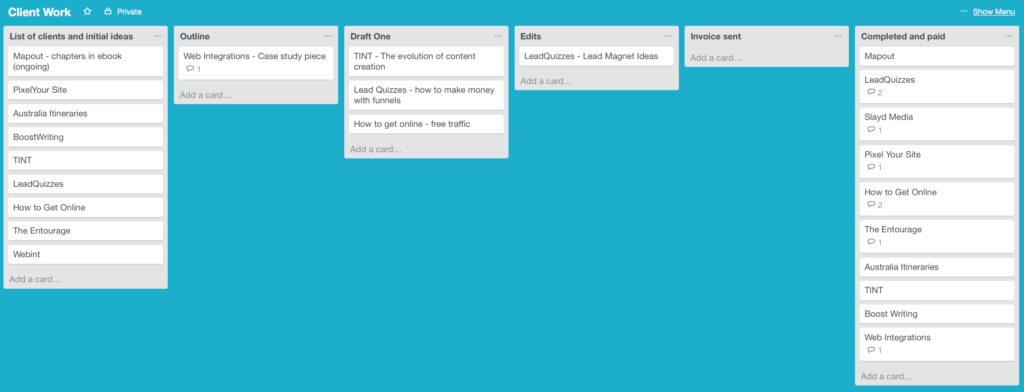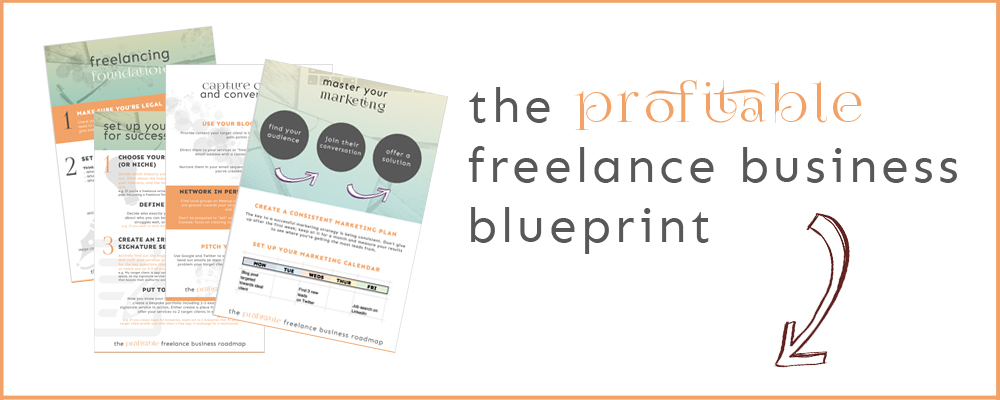Psssttt...

Ready to find high-paying clients and build a profitable business?
Get your free copy of Win More Clients, a 20+ page eBook that shows you how to get paid more and the secret sauce you need to create a sustainable freelance business
When you’re starting out freelancing, it can seem like you’ll never have enough projects to balance.
Then, all of a sudden, you’ve got 3 clients, each of which have 2 projects. Then that doubles, and doubles again, until suddenly you can’t even think about your week without breaking out into a cold sweat.
I’ve been there. Oh, heck have I been there.
Up until the start of this year (that’s almost two and a half years of freelancing), I didn’t have an ogranisational system except a paper diary that I jotted down what I needed to do each day of the week in on the Sunday before said week began.
It was bad.
But I’m really not one of those people who has hundreds of different apps and tools for various different parts of my business. In fact, I like to keep it as simple as possible, so the thought of learning and implementing a new tool or system to organise my weeks was daunting.
Especially because my paper system had worked up until then. I hadn’t missed a deadline, I hadn’t missed a piece, and I managed to plan my days out evenly so I was working a similar amount of hours each day.
So why did I change it?
I’d put a new system in place for client work.
Instead of working with each client in a unique way, I put in a workflow for each and every client that meant I knew where I was in each project.
Whereas before my process looked something like this:
- Client #1: Send ideas, write piece, upload into WordPress
- Client #2: Send outline, send first draft, send edits
My new workflow is a lot more streamlined:
- Client #1: Send ideas, write outline, send first draft, send edits, send invoice
- Client #2: Same as above
It meant that I knew what the next step was for each and every client and didn’t have to remember what my individual workflow looked like for each one.
My clients were fine with this. I told them it would make the process run smoother and not much would change for them so, naturally, they were a-ok with it.
I implemented this new system at the end of January, but figured I needed a more structured approach to organising it if I wanted it to last longer than any of the other technical tools I’d attempted to try out in the past (spoiler: not long at ALL!).
Introducing Trello as an Organisational Tool
I’d used Trello in the past for some client projects, but hadn’t really given it my full attention.
However, I liked the way that it’s a visual platform where you can see everything laid out in front of you like a funnel kind of system.

This is what my client workflow board looks like.
On the left-hand side, I have a list of the clients I do ongoing, regular work for (there are a few not listed here that I do ad hoc stuff for). For most of these clients, I write at least one piece a week.
The second column is the “outlining” column.
When I’ve been given the go-ahead to write a piece I’ve pitched or the client has come up with, I add a new card in this column with the title of the piece in.
When the outline has been submitted and has been approved, I work on the first draft. Once that’s completed, I move the card from the outline column into the first draft column, and I then wait for any edits to come in from the client.
If there are any edits, the card gets moved into the edits column as I work on those, and then I’ll send it back to the client for final approval (I only offer one edit on pieces before charging more).
Finally, once that’s been approved, I’ll send the invoice and move the card across into the “invoice sent” column.
Once the money has arrived in my bank account, I add a comment to the card relating to the relevant client with the title of the piece.
It’s a simple process, but I’m able to look at it in one go and see where I’m at with each piece for each client which is MUCH better than flicking through pages of a paper diary trying to figure out when I did an outline for a client and when they’re expecting the draft to be submitted.

Managing Client Acquisition with Trello
I don’t just use Trello to managing my workflow, though. Oh no.
I’ve also started using it to document client acquisition so I can see where I’m getting most of my clients from and how successful my onboarding process is.
It looks very basic at the moment because I only started it last month and I haven’t been actively looking for clients in that time, but let’s break it down.

In the first column I put the name of the potential client, and in the second I put whether I’ve given them my prices or not (usually the thing that puts most clients off).
Afterwards, I follow up a week or so later if I haven’t heard back from them (the client in the follow-up column here has actively expressed interest in hiring me but they are sorting out their content strategy this month, hence why the card hasn’t been moved along yet).
Then I have two columns for “hired” and “not hired”. As you can see, there are no clients in the “hired” column yet because no new contracts have been signed in the last month.
In the “not hired” column, within the card I detail why the client didn’t hire me (spoiler: I’m usually too expensive for them).
So these are the two ways I actively use Trello to manage two separate parts of my freelance business.
I’m finding it easier and easier to fire up Trello every morning to see where I’m at, and it’s becoming second nature to start moving cards around when I’m working on pieces.
In the future, I’d like to start using the colour codes and other neat features of Trello, but I’m taking it day by day – this is a big ol’ step for a gal who so loves her paper diary!







I currently use Wunderlist (mainly because I’ve only got one client). So I put in ‘brainstorm content ideas’, and then when she responds with the ones she likes, I then add ‘research post’ and set a deadline for a few days later. When I tick that off, I then add ‘write post’ as a to-do. Rinse and repeat.
But I like the idea of moving things along the boards. It’s like the kanban system! Maybe one day I’ll have more clients and I can put it in place!
After reading this I decided to use it as well and man oh man! I’ve always been an advocate for Asana and Basecamp, but this is way simpler! I love that everything is on one screen. In fact, that is my favorite feature of it. Thanks for the share 🙂
Yes! LOVE that you found a simpler way to organise things and that I could help you with that 😀 the fact everything is on one screen is my favourite thing about it, too!